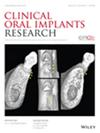Antibacterial Effect of Combined Electrolytic and Chemical Decontamination Methods on Dental Implant Surfaces: In Vitro Study.
IF 5.3
1区 医学
Q1 DENTISTRY, ORAL SURGERY & MEDICINE
引用次数: 0
Abstract
OBJECTIVES To evaluate the combined effect of direct electrical current and chlorhexidine digluconate (CHX) for decontaminating titanium implant surfaces, using a validated in vitro oral multispecies biofilm model. MATERIAL AND METHODS Contaminated implant surfaces were tested using an electrochemical cell consisting of a three-electrode system immersed in a KI-AL electrolyte, the biofilm-coated implant being the working electrode, a platinum mesh the counter electrode, and an Ag/AgCl electrode the reference. Direct electrical currents (DC) were applied at two voltage levels (-3 V and-0.75 V) for 5 min, followed by a 1-min rinse in 0.12% CHX. The results were compared to 0.12% CHX alone. Untreated contaminated implants served as negative controls. The antibiofilm effect was evaluated by quantitative polymerase chain reaction with propidium monoazide and by scanning electron microscopy in three different implant zones (threads, valleys and transmucosal machined neck). The area of residual bacteria was also calculated by image analysis. RESULTS The combined treatment significantly reduced the viable total bacterial counts ([-3 V + CHX] = 4.6 and [-0.75 V + CHX] = 4.9 logarithm colony forming units-LogCFU/mL), compared to the negative control group (6.1 LogCFU/mL) and 0.12% CHX alone (6.3 LogCFU/mL). The area of residual bacteria was also significantly reduced, removing over 95% of the biofilm in combined treatment groups, with slightly higher efficiency at -3 V. Electrolytic cleaning was able to reach all implant zones and no significant differences were found between [-3 V + CHX] and [-0.75 V + CHX] for any parameter. CONCLUSION The proposed combined treatments were more effective in reducing the vitality of multispecies biofilms on implant surfaces compared to CHX alone.电解与化学联合消毒对种植体表面抗菌效果的体外研究。
目的采用体外口腔多物种生物膜模型,评价直流电流联合二光酸氯己定(CHX)对钛种植体表面去污的效果。材料和方法使用浸在KI-AL电解质中的三电极系统组成的电化学电池对受污染的植入物表面进行测试,生物膜覆盖的植入物为工作电极,铂网为反电极,Ag/AgCl电极为参比电极。在两个电压水平(-3 V和0.75 V)下施加直流电流(DC) 5分钟,然后在0.12% CHX中冲洗1分钟。结果与单独使用0.12% CHX进行比较。未处理的污染植入物作为阴性对照。采用单叠氮丙啶定量聚合酶链反应和扫描电镜对三个不同种植区域(螺纹区、谷区和经黏膜加工颈部)的抗菌膜效果进行评价。并通过图像分析计算出残留细菌的面积。结果与阴性对照组(6.1 LogCFU/mL)和单独使用0.12% CHX组(6.3 LogCFU/mL)相比,联合处理显著降低了活菌总数([-3 V + CHX] = 4.6和[-0.75 V + CHX] = 4.9对数菌落形成单位-LogCFU/mL)。残余细菌的面积也显著减少,联合处理组的生物膜去除率超过95%,在-3 V时效率略高。电解清洗能够到达种植体的所有区域,在[-3 V + CHX]和[-0.75 V + CHX]之间没有发现任何参数的显着差异。结论与单纯CHX治疗相比,联合治疗可有效降低种植体表面多物种生物膜的活性。
本文章由计算机程序翻译,如有差异,请以英文原文为准。
求助全文
约1分钟内获得全文
求助全文
来源期刊

Clinical Oral Implants Research
医学-工程:生物医学
CiteScore
7.70
自引率
11.60%
发文量
149
审稿时长
3 months
期刊介绍:
Clinical Oral Implants Research conveys scientific progress in the field of implant dentistry and its related areas to clinicians, teachers and researchers concerned with the application of this information for the benefit of patients in need of oral implants. The journal addresses itself to clinicians, general practitioners, periodontists, oral and maxillofacial surgeons and prosthodontists, as well as to teachers, academicians and scholars involved in the education of professionals and in the scientific promotion of the field of implant dentistry.
 求助内容:
求助内容: 应助结果提醒方式:
应助结果提醒方式:


